Similar presentations:
Data Mining: Concepts and Techniques (3rd ed.) — Chapter 1 — Farid Feyzi
1. Data Mining: Concepts and Techniques (3rd ed.) — Chapter 1 — Farid Feyzi
12. Grading Policy
Mid-Exam: 25%Final Exam: 40%
Research Work (with Presentation): 15(up to 25)%
Project: 20%
2
3. Chapter 1. Introduction
Why Data Mining?What Is Data Mining?
A Multi-Dimensional View of Data Mining
What Kind of Data Can Be Mined?
What Kinds of Patterns Can Be Mined?
What Technology Are Used?
What Kind of Applications Are Targeted?
Major Issues in Data Mining
A Brief History of Data Mining and Data Mining Society
Summary
3
4. Why Data Mining?
The Explosive Growth of Data: from terabytes to petabytesData collection and data availability
Automated data collection tools, database systems, Web,
computerized society
Major sources of abundant data
Business: Web, e-commerce, transactions, stocks, …
Science: Remote sensing, bioinformatics, scientific simulation, …
Society and everyone: news, digital cameras, YouTube
We are drowning in data, but starving for knowledge!
“Necessity is the mother of invention”—Data mining—Automated
analysis of massive data sets
4
5. Why do we need data mining?
• Really, really huge amounts of raw data!!• In the digital age, TB of data is generated by the
second
• Mobile devices, digital photographs, web documents.
• Facebook updates, Tweets, Blogs, User-generated
content
• Transactions, sensor data, surveillance data
• Queries, clicks, browsing
• Cheap storage has made possible to maintain this
data
• Need to analyze the raw data to extract
knowledge
5
6. Why do we need data mining?
• “The data is the computer”• Large amounts of data can be more powerful than
complex algorithms and models
• Google has solved many Natural Language Processing
problems, simply by looking at the data
• Example: misspellings, synonyms
• Data is power!
• Today, the collected data is one of the biggest assets of an
online company
Query logs of Google
The friendship and updates of Facebook
Tweets and follows of Twitter
Amazon transactions
6
7. Data Mining as the Evolution of Information Technology
1960s:1970s:
Relational data model, relational DBMS implementation
1980s:
RDBMS, advanced data models (extended-relational, OO, deductive, etc.)
Application-oriented DBMS (spatial, scientific, engineering, etc.)
1990s:
Data collection, database creation, IMS and network DBMS
Data mining, data warehousing, multimedia databases, and Web
databases
2000s
Stream data management and mining
Data mining and its applications
Web technology (XML, data integration) and global information systems
7
8. Chapter 1. Introduction
Why Data Mining?What Is Data Mining?
A Multi-Dimensional View of Data Mining
What Kind of Data Can Be Mined?
What Kinds of Patterns Can Be Mined?
What Technology Are Used?
What Kind of Applications Are Targeted?
Major Issues in Data Mining
A Brief History of Data Mining and Data Mining Society
Summary
8
9. What Is Data Mining?
Data mining (knowledge discovery from data)Extraction of interesting (non-trivial, implicit, previously
unknown and potentially useful) patterns or knowledge from
huge amount of data
Alternative names
Data mining: a misnomer?
Knowledge discovery (mining) in databases (KDD), knowledge
extraction, data/pattern analysis, data archeology, data
dredging, information harvesting, business intelligence, etc.
Watch out: Is everything “data mining”?
Simple search and query processing
(Deductive) expert systems
9
10. Knowledge Discovery (KDD) Process
The knowledge discovery process is an iterativesequence of the following steps:
1. Data cleaning (to remove noise and inconsistent data)
2. Data integration (where multiple data sources may be
combined)
3. Data selection (where data relevant to the analysis task
are retrieved from the database)
4. Data transformation (where data are transformed and
consolidated into forms appropriate for mining by
performing summary or aggregation operations)
10
11. Knowledge Discovery (KDD) Process
The knowledge discovery process is an iterativesequence of the following steps:
5. Data mining (an essential process where intelligent
methods are applied to extract data patterns)
6. Pattern evaluation (to identify the truly interesting
patterns representing knowledge based on interestingness
measures)
7. Knowledge presentation (where visualization and
knowledge representation techniques are used to present
mined knowledge to users)
11
12. Example: A Web Mining Framework
Web mining usually involvesData cleaning
Data integration from multiple sources
Warehousing the data
Data cube construction
Data selection for data mining
Data mining
Presentation of the mining results
Patterns and knowledge to be used or stored into
knowledge-base
12
13. Data Mining in Business Intelligence
Increasing potentialto support
business decisions
Decision
Making
Data Presentation
Visualization Techniques
End User
Business
Analyst
Data Mining
Information Discovery
Data
Analyst
Data Exploration
Statistical Summary, Querying, and Reporting
Data Preprocessing/Integration, Data Warehouses
Data Sources
Paper, Files, Web documents, Scientific experiments, Database Systems
DBA
13
14. KDD Process: A Typical View from ML and Statistics
Input DataData PreProcessing
Data integration
Normalization
Feature selection
Dimension reduction
Data
Mining
Pattern discovery
Association & correlation
Classification
Clustering
Outlier analysis
…………
PostProcessing
Pattern
Pattern
Pattern
Pattern
evaluation
selection
interpretation
visualization
This is a view from typical machine learning and statistics communities
14
15. Example: Medical Data Mining
Health care & medical data mining – oftenadopted such a view in statistics and machine
learning
Preprocessing of the data (including feature
extraction and dimension reduction)
Classification or/and clustering processes
Post-processing for presentation
15
16. Chapter 1. Introduction
Why Data Mining?What Is Data Mining?
A Multi-Dimensional View of Data Mining
What Kind of Data Can Be Mined?
What Kinds of Patterns Can Be Mined?
What Technology Are Used?
What Kind of Applications Are Targeted?
Major Issues in Data Mining
A Brief History of Data Mining and Data Mining Society
Summary
16
17. Multi-Dimensional View of Data Mining
Data to be minedDatabase data (extended-relational, object-oriented, heterogeneous,
legacy), data warehouse, transactional data, stream, spatiotemporal,
time-series, sequence, text and web, multi-media, graphs & social
and information networks
Knowledge to be mined (or: Data mining functions)
Characterization, discrimination, association, classification,
clustering, trend/deviation, outlier analysis, etc.
Descriptive vs. predictive data mining
Multiple/integrated functions and mining at multiple levels
Techniques utilized
Data-intensive, data warehouse (OLAP), machine learning, statistics,
pattern recognition, visualization, high-performance, etc.
Applications adapted
Retail, telecommunication, banking, fraud analysis, bio-data mining,
stock market analysis, text mining, Web mining, etc.
17
18. Chapter 1. Introduction
Why Data Mining?What Is Data Mining?
A Multi-Dimensional View of Data Mining
What Kind of Data Can Be Mined?
What Kinds of Patterns Can Be Mined?
What Technology Are Used?
What Kind of Applications Are Targeted?
Major Issues in Data Mining
A Brief History of Data Mining and Data Mining Society
Summary
18
19. Data Mining: On What Kinds of Data?
Database-oriented data sets and applicationsRelational database, data warehouse, transactional database
Advanced data sets and advanced applications
Data streams and sensor data
Time-series data, temporal data, sequence data (incl. bio-sequences)
Structure data, graphs, social networks and multi-linked data
Object-relational databases
Heterogeneous databases and legacy databases
Spatial data and spatiotemporal data
Multimedia database
Text databases
The World-Wide Web
19
20. The data is also very complex
• Multiple types of data: tables, time series,images, graphs, etc
• Spatial and temporal aspects
• Interconnected data of different types:
• From the mobile phone we can collect, location of the
user, friendship information, check-ins to venues,
opinions through twitter, images though cameras,
queries to search engines
20
21. Example: transaction data
• Billions of real-life customers:• WALMART: 20M transactions per day
• AT&T 300 M calls per day
• Credit card companies: billions of transactions per day.
• The point cards allow companies to collect
information about specific users
21
22. Example: document data
• Web as a document repository: estimated 50billions of web pages
• Wikipedia: 4 million articles (and counting)
• Online news portals: steady stream of 100’s of
new articles every day
• Twitter: ~300 million tweets every day
22
23. Example: network data
• Web: 50 billion pages linked via hyperlinks• Facebook: 500 million users
• Twitter: 300 million users
• Instant messenger: ~1billion users
• Blogs: 250 million blogs worldwide, presidential
candidates run blogs
23
24. Example: genomic sequences
• http://www.1000genomes.org/page.php• Full sequence of 1000 individuals
• 3*109 nucleotides per person 3*1012
nucleotides
• Lots more data in fact: medical history of the
persons, gene expression data
24
25. Example: environmental data
• Climate data (just an example)http://www.ncdc.gov/oa/climate/ghcn-monthly/index.php
• “a database of temperature, precipitation and
pressure records managed by the National Climatic
Data Center, Arizona State University and the Carbon
Dioxide Information Analysis Center”
• “6000 temperature stations, 7500 precipitation
stations, 2000 pressure stations”
• Spatiotemporal data
25
26. Behavioral data
• Mobile phones today record a large amount of information about theuser behavior
GPS records position
Camera produces images
Communication via phone and SMS
Text via facebook updates
Association with entities via check-ins
• Amazon collects all the items that you browsed, placed into your
basket, read reviews about, purchased.
• Google and Bing record all your browsing activity via toolbar plugins.
They also record the queries you asked, the pages you saw and the
clicks you did.
• Data collected for millions of users on a daily basis
26
27. So, what is Data?
AttributesSo, what is Data?
Tid Refund Marital
Status
Taxable
Income Cheat
1
Yes
Single
125K
No
2
No
Married
100K
No
• An attribute is a property or
3
No
Single
70K
No
characteristic of an object
4
Yes
Married
120K
No
5
No
Divorced 95K
Yes
6
No
Married
No
7
Yes
Divorced 220K
No
8
No
Single
85K
Yes
9
No
Married
75K
No
10
No
Single
90K
Yes
• Collection of data objects and
their attributes
• Examples: eye color of a person,
temperature, etc.
• Attribute is also known as
variable, field, characteristic, or
feature
Objects
• A collection of attributes describe
an object
• Object is also known as record,
point, case, sample, entity, or
instance
60K
10
Size: Number of objects
Dimensionality: Number of attributes
Sparsity: Number of populated
object-attribute pairs
27
28. Types of Attributes
• There are different types of attributes• Categorical
Examples: eye color, zip codes, words, rankings (e.g, good,
fair, bad), height in {tall, medium, short}
Nominal (no order or comparison) vs Ordinal (order but not
comparable)
• Numeric
• Examples: dates, temperature, time, length, value, count.
• Discrete (counts) vs Continuous (temperature)
• Special case: Binary attributes (yes/no, exists/not exists)
28
29. Numeric Record Data
• If data objects have the same fixed set of numericattributes, then the data objects can be thought of as
points in a multi-dimensional space, where each
dimension represents a distinct attribute
• Such data set can be represented by an n-by-d data
matrix, where there are n rows, one for each object, and d
columns, one for each attribute
Projection
of x Load
Projection
of y load
Distance
Load
Thickness
10.23
5.27
15.22
2.7
1.2
12.65
6.25
16.22
2.2
1.1
29
30. Categorical Data
• Data that consists of a collection of records, eachof which consists of a fixed set of categorical
attributes
Tid Refund Marital
Status
Taxable
Income Cheat
1
Yes
Single
High
No
2
No
Married
Medium
No
3
No
Single
Low
No
4
Yes
Married
High
No
5
No
Divorced Medium
Yes
6
No
Married
Low
No
7
Yes
Divorced High
No
8
No
Single
Medium
Yes
9
No
Married
Medium
No
10
No
Single
Medium
Yes
10
30
31. Document Data
• Each document becomes a `term' vector,• each term is a component (attribute) of the vector,
• the value of each component is the number of times the
corresponding term occurs in the document.
• Bag-of-words representation – no ordering
team
coach
pla
y
ball
score
game
wi
n
lost
timeout
season
Document 1
3
0
5
0
2
6
0
2
0
2
Document 2
0
7
0
2
1
0
0
3
0
0
Document 3
0
1
0
0
1
2
2
0
3
0
31
32. Transaction Data
• Each record (transaction) is a set of items.TID
Items
1
Bread, Coke, Milk
2
3
4
5
Beer, Bread
Beer, Coke, Diaper, Milk
Beer, Bread, Diaper, Milk
Coke, Diaper, Milk
• A set of items can also be represented as a binary
vector, where each attribute is an item.
• A document can also be represented as a set of
words (no counts)
Sparsity: average number of products bought by a customer
32
33. Ordered Data
• Genomic sequence dataGGTTCCGCCTTCAGCCCCGCGCC
CGCAGGGCCCGCCCCGCGCCGTC
GAGAAGGGCCCGCCTGGCGGGCG
GGGGGAGGCGGGGCCGCCCGAGC
CCAACCGAGTCCGACCAGGTGCC
CCCTCTGCTCGGCCTAGACCTGA
GCTCATTAGGCGGCAGCGGACAG
GCCAAGTAGAACACGCGAAGCGC
TGGGCTGCCTGCTGCGACCAGGG
• Data is a long ordered string
33
34. Ordered Data
• Time series• Sequence of ordered (over “time”) numeric values.
34
35. Graph Data
• Examples: Web graph and HTML Links2
1
5
2
<a href="papers/papers.html#bbbb">
Data Mining </a>
<li>
<a href="papers/papers.html#aaaa">
Graph Partitioning </a>
<li>
<a href="papers/papers.html#aaaa">
Parallel Solution of Sparse Linear System of Equations </a>
<li>
<a href="papers/papers.html#ffff">
N-Body Computation and Dense Linear System Solvers
5
35
36. Chapter 1. Introduction
Why Data Mining?What Is Data Mining?
A Multi-Dimensional View of Data Mining
What Kind of Data Can Be Mined?
What Kinds of Patterns Can Be Mined?
What Technology Are Used?
What Kind of Applications Are Targeted?
Major Issues in Data Mining
A Brief History of Data Mining and Data Mining Society
Summary
36
37. Data Mining Function: (1) Generalization
Information integration and data warehouse constructionData cube technology (See the Next Slide)
Data cleaning, transformation, integration, and
multidimensional data model
Scalable methods for computing (i.e., materializing)
multidimensional aggregates
OLAP (online analytical processing)
Multidimensional concept description: Characterization
and discrimination
Generalize, summarize, and contrast data
characteristics, e.g., dry vs. wet region
37
38. Data cube technology
Data cube technologyداده ها در دو بعد ذخیره شده اند
در مکعبداده ،دادهها به صورت چند بُعدی
نمایش داده میشوند و هر بُعد یک ویژگی از
انبارداده ما را نمایش میدهد(زمان فروش،
مکان فروش ،نوع اجناس فروخته شده)
38
39. Data Mining Function: (2) Association and Correlation Analysis
Frequent patterns (or frequent itemsets)What items are frequently purchased together in your
Walmart?
Association, correlation vs. causality
A typical association rule
Diaper Beer [0.5%, 75%] (support, confidence)
Are strongly associated items also strongly correlated?
How to mine such patterns and rules efficiently in large
datasets?
How to use such patterns for classification, clustering,
and other applications?
39
40. Data Mining Function: (3) Classification
Classification and label predictionConstruct models (functions) based on some training examples
Describe and distinguish classes or concepts for future prediction
Predict some unknown class labels
Typical methods
E.g., classify countries based on (climate), or classify cars
based on (gas mileage)
Decision trees, naïve Bayesian classification, support vector
machines, neural networks, rule-based classification, patternbased classification, logistic regression, …
Typical applications:
Credit card fraud detection, direct marketing, classifying stars,
diseases, web-pages, …
40
41. Data Mining Function: (3) Classification
4142. Data Mining Function: (4) Cluster Analysis
Unsupervised learning (i.e., Class label is unknown)Group data to form new categories (i.e., clusters), e.g.,
cluster houses to find distribution patterns
Principle: Maximizing intra-class similarity & minimizing
interclass similarity
Many methods and applications
42
43. Data Mining Function: (4) Cluster Analysis
4344. Data Mining Function: (5) Outlier Analysis
Outlier analysisOutlier: A data object that does not comply with the general
behavior of the data
Noise or exception? ― One person’s garbage could be another
person’s treasure
Methods: by product of clustering or regression analysis, …
Useful in fraud detection, rare events analysis
44
45. What can you do with the data?
• Suppose that you are the owner of a supermarketand you have collected billions of market basket
data. What information would you extract from it
and how would you use it?
TID
Items
1
2
3
4
5
Bread, Coke, Milk
Beer, Bread
Beer, Coke, Diaper, Milk
Beer, Bread, Diaper, Milk
Coke, Diaper, Milk
Product placement
Catalog creation
Recommendations
• What if this was an online store?
44
46. What can you do with the data?
• Suppose you are a search engine and you havea toolbar log consisting of
• pages browsed,
• queries,
Ad click prediction
• pages clicked,
• ads clicked
Query reformulations
each with a user id and a timestamp. What
information would you like to get our of the data?
45
47. What can you do with the data?
• Suppose you are biologist who has microarrayexpression data: thousands of genes, and their
expression values over thousands of different
settings (e.g. tissues). What information would you
like to get out of your data?
Groups of genes and tissues
46
48. What can you do with the data?
• Suppose you are a stock broker and you observethe fluctuations of multiple stocks over time. What
information would you like to get our of your
data?
Clustering of stocks
Correlation of stocks
Stock Value prediction
49. What can you do with the data?
• You are the owner of a social network, and youhave full access to the social graph, what kind of
information do you want to get out of your graph?
Who is the most important node in the graph?
What is the shortest path between two nodes?
How many friends two nodes have in common?
How does information spread on the network?
48
50. Time and Ordering: Sequential Pattern, Trend and Evolution Analysis
Sequence, trend and evolution analysisTrend, time-series, and deviation analysis: e.g.,
regression and value prediction
Sequential pattern mining
e.g., first buy digital camera, then buy large SD
memory cards
Periodicity analysis (in time-series)
Motifs and biological sequence analysis
Approximate and consecutive motifs
Similarity-based analysis
Mining data streams
Ordered, time-varying, potentially infinite, data streams
50
51. Time and Ordering: Sequential Pattern, Trend and Evolution Analysis
Sequential pattern mining:an important data mining task with a wide range of
applications from text analysis to market basket analysis
This database contains four sequences(ordered list of
itemsets). Each sequence represents the items
purchased by a customer at different times.
Find the sequences of items frequently bought by customers
51
52. Structure and Network Analysis
Graph miningFinding frequent subgraphs (e.g., chemical compounds-malware
analysis), trees (XML), substructures (web fragments)
Information network analysis
Social networks: actors (objects, nodes) and relationships (edges)
e.g., author networks in CS, terrorist networks
Multiple heterogeneous networks
A person could be multiple information networks: friends,
family, classmates, …
Links carry a lot of semantic information: Link mining
Web mining
Web is a big information network: from PageRank to Google
Analysis of Web information networks
Web community discovery, opinion mining, usage mining, …
52
53. Evaluation of Knowledge
Are all mined knowledge interesting?One can mine tremendous amount of “patterns” and knowledge
Some may fit only certain dimension space (time, location, …)
Some may not be representative, may be transient, …
Evaluation of mined knowledge → directly mine only
interesting knowledge?
Descriptive vs. predictive
Coverage(for classification-Similar to support)
Typicality vs. novelty
Accuracy(for classification)
Timeliness
…
53
54. What can we do with data mining?
• Some examples:• Frequent itemsets and Association Rules extraction
• Coverage
• Clustering
• Classification
• Ranking
• Exploratory analysis
52
55. Frequent Itemsets and Association Rules
• Given a set of records each of which contain somenumber of items from a given collection;
• Identify sets of items (itemsets) occurring frequently
together
• Produce dependency rules which will predict
occurrence of an item based on occurrences of other
items.
Itemsets Discovered:
TID
Items
1
2
3
4
5
Bread, Coke, Milk
Beer, Bread
Beer, Coke, Diaper, Milk
Beer, Bread, Diaper, Milk
Coke, Diaper, Milk
{Milk,Coke}
{Diaper, Milk}
Rules Discovered:
{Milk} --> {Coke}
{Diaper, Milk} --> {Beer}
53
56. Frequent Itemsets: Applications
• Text mining: finding associated phrases in text• There are lots of documents that contain the phrases
“association rules”, “data mining” and “efficient
algorithm”
• Recommendations:
• Users who buy this item often buy this item as well
• Users who watched James Bond movies, also watched
Jason Bourne movies.
• Recommendations make use of item and user similarity
54
57. Association Rule Discovery: Application
• Supermarket shelf management.• Goal: To identify items that are bought together by
sufficiently many customers.
• Approach: Process the point-of-sale data collected
with barcode scanners to find dependencies among
items.
• A classic rule -• If a customer buys diaper and milk, then he is very likely to
buy beer.
• So, don’t be surprised if you find six-packs stacked next to
diapers!
55
58. Clustering Definition
• Given a set of data points, each having a set ofattributes, and a similarity measure among them,
find clusters such that
• Data points in one cluster are more similar to one
another.
• Data points in separate clusters are less similar to
one another.
• Similarity Measures?
• Euclidean Distance if attributes are continuous.
• Other Problem-specific Measures.
56
59. Illustrating Clustering
Euclidean Distance Based Clustering in 3-D space.Intracluster distances
are minimized
Intercluster distances
are maximized
57
60. Clustering: Application 1
• Bioinformatics applications:• Goal: Group genes and tissues together such that genes are
coexpressed on the same tissues
58
61. Clustering: Application 2
• Document Clustering:• Goal: To find groups of documents that are similar to
each other based on the important terms appearing in
them.
• Approach: To identify frequently occurring terms in
each document. Form a similarity measure based on
the frequencies of different terms. Use it to cluster.
• Gain: Information Retrieval can utilize the clusters to
relate a new document or search term to clustered
documents.
59
62. Clustering of S&P 500 Stock Data
Clustering of S&P 500 Stock DataObserve Stock Movements every day.
Cluster stocks if they change similarly over time.
Discovered Clusters
1
2
3
4
Applied-Matl-DOW N,Bay-Net work-Down,3-COM-DOWN,
Cabletron-Sys-DOWN,CISCO-DOWN,HP-DOWN,
DSC-Co mm-DOW N,INTEL-DOWN,LSI-Logic-DOWN,
Micron-Tech-DOWN,Texas-Inst-Down,Tellabs-Inc-Down,
Natl-Semiconduct-DOWN,Oracl-DOWN,SGI-DOW N,
Sun-DOW N
Apple-Co mp-DOW N,Autodesk-DOWN,DEC-DOWN,
ADV-M icro-Device-DOWN,Andrew-Corp-DOWN,
Co mputer-Assoc-DOWN,Circuit-City-DOWN,
Co mpaq-DOWN, EM C-Corp-DOWN, Gen-Inst-DOWN,
Motorola-DOW N,Microsoft-DOWN,Scientific-Atl-DOWN
Fannie-Mae-DOWN,Fed-Ho me-Loan-DOW N,
MBNA-Corp -DOWN,Morgan-Stanley-DOWN
Baker-Hughes-UP,Dresser-Inds-UP,Halliburton-HLD-UP,
Louisiana-Land-UP,Phillips-Petro-UP,Unocal-UP,
Schlu mberger-UP
Industry Group
Technology1-DOWN
Technology2-DOWN
Financial-DOWN
Oil-UP
60
63. Coverage
• Given a set of customers and items and thetransaction relationship between the two, select a
small set of items that “covers” all users.
• For each user there is at least one item in the set that
the user has bought.
• Application:
• Create a catalog to send out that has at least one item
of interest for every customer.
61
64. Classification: Definition
• Given a collection of records (training set )• Each record contains a set of attributes, one of the
attributes is the class.
• Find a model for class attribute as a function
of the values of other attributes.
• Goal: previously unseen records should be
assigned a class as accurately as possible.
• A test set is used to determine the accuracy of the
model. Usually, the given data set is divided into
training and test sets, with training set used to build
the model and test set used to validate it.
62
65. Classification Example
Tid Refund MaritalStatus
Taxable
Income Cheat
Refund Marital
Status
Taxable
Income Cheat
1
Yes
Single
125K
No
No
Single
75K
?
2
No
Married
100K
No
Yes
Married
50K
?
3
No
Single
70K
No
No
Married
150K
?
4
Yes
Married
120K
No
Yes
Divorced 90K
?
5
No
Divorced 95K
Yes
No
Single
40K
?
6
No
Married
No
No
Married
80K
?
60K
10
7
Yes
Divorced 220K
No
8
No
Single
85K
Yes
9
No
Married
75K
No
10
10
No
Single
90K
Yes
Training
Set
Learn
Classifier
Test
Set
Model
63
66. Classification: Application 1
• Ad Click Prediction• Goal: Predict if a user that visits a web page will click
on a displayed ad. Use it to target users with high
click probability.
• Approach:
• Collect data for users over a period of time and record who
clicks and who does not. The {click, no click} information
forms the class attribute.
• Use the history of the user (web pages browsed, queries
issued) as the features.
• Learn a classifier model and test on new users.
64
67. Classification: Application 2
• Fraud Detection• Goal: Predict fraudulent cases in credit card
transactions.
• Approach:
• Use credit card transactions and the information on its
account-holder as attributes.
• When does a customer buy, what does he buy, how often he pays on
time, etc
• Label past transactions as fraud or fair transactions. This
forms the class attribute.
• Learn a model for the class of the transactions.
• Use this model to detect fraud by observing credit card
transactions on an account.
65
68. Link Analysis Ranking
• Given a collection of web pages that are linked toeach other, rank the pages according to
importance (authoritativeness) in the graph
• Intuition: A page gains authority if it is linked to by
another page.
• Application: When retrieving pages, the
authoritativeness is factored in the ranking.
66
69. Exploratory Analysis
• Trying to understand the data as a physicalphenomenon, and describe them with simple metrics
• What does the web graph look like?
• How often do people repeat the same query?
• Are friends in facebook also friends in twitter?
• In statistics, exploratory data analysis (EDA) is an
approach to analyzing data sets to summarize their
main characteristics, often with visual methods.
• It helps our understanding of the world, and can lead
to models of the phenomena we observe.
67
70. Exploratory Analysis: The Web
• What is the structure and the properties of theweb?
• The Bow-Tie Structure of the Web
68
71. Exploratory Analysis: The Web
• What is the distribution of the incoming links?69
72. Chapter 1. Introduction
Why Data Mining?What Is Data Mining?
A Multi-Dimensional View of Data Mining
What Kind of Data Can Be Mined?
What Kinds of Patterns Can Be Mined?
What Technology Are Used?
What Kind of Applications Are Targeted?
Major Issues in Data Mining
A Brief History of Data Mining and Data Mining Society
Summary
72
73. Data Mining: Confluence of Multiple Disciplines
MachineLearning
Applications
Algorithm
Pattern
Recognition
Data Mining
Database
Technology
Statistics
Visualization
High-Performance
Computing
73
74. Why Confluence of Multiple Disciplines?
Tremendous amount of dataHigh-dimensionality of data
Micro-array may have tens of thousands of dimensions
High complexity of data
Algorithms must be highly scalable to handle such as tera-bytes of
data
Data streams and sensor data
Time-series data, temporal data, sequence data
Structure data, graphs, social networks and multi-linked data
Heterogeneous databases and legacy databases
Spatial, spatiotemporal, multimedia, text and Web data
Software programs, scientific simulations
New and sophisticated applications
74
75. Chapter 1. Introduction
Why Data Mining?What Is Data Mining?
A Multi-Dimensional View of Data Mining
What Kind of Data Can Be Mined?
What Kinds of Patterns Can Be Mined?
What Technology Are Used?
What Kind of Applications Are Targeted?
Major Issues in Data Mining
A Brief History of Data Mining and Data Mining Society
Summary
75
76. Applications of Data Mining
Web page analysis: from web page classification, clustering toPageRank & HITS algorithms
Collaborative analysis & recommender systems
Basket data analysis to targeted marketing
Biological and medical data analysis: classification, cluster analysis
(microarray data analysis), biological sequence analysis, biological
network analysis
Data mining and software engineering (e.g., IEEE Computer, Aug.
2009 issue)
From major dedicated data mining systems/tools (e.g., SAS, MS SQLServer Analysis Manager, Oracle Data Mining Tools) to invisible data
mining
76
77. Chapter 1. Introduction
Why Data Mining?What Is Data Mining?
A Multi-Dimensional View of Data Mining
What Kind of Data Can Be Mined?
What Kinds of Patterns Can Be Mined?
What Technology Are Used?
What Kind of Applications Are Targeted?
Major Issues in Data Mining
A Brief History of Data Mining and Data Mining Society
Summary
77
78. Major Issues in Data Mining (1)
Mining MethodologyMining various and new kinds of knowledge
Mining knowledge in multi-dimensional space
Data mining: An interdisciplinary effort
Boosting the power of discovery in a networked environment
Handling noise, uncertainty, and incompleteness of data
Pattern evaluation and pattern- or constraint-guided mining
User Interaction
Interactive mining
Incorporation of background knowledge
Presentation and visualization of data mining results
78
79. Major Issues in Data Mining (2)
Efficiency and ScalabilityEfficiency and scalability of data mining algorithms
Parallel, distributed, stream, and incremental mining methods
Diversity of data types
Handling complex types of data
Mining dynamic, networked, and global data repositories
Data mining and society
Social impacts of data mining
Privacy-preserving data mining
Invisible data mining
79
80. Chapter 1. Introduction
Why Data Mining?What Is Data Mining?
A Multi-Dimensional View of Data Mining
What Kind of Data Can Be Mined?
What Kinds of Patterns Can Be Mined?
What Technology Are Used?
What Kind of Applications Are Targeted?
Major Issues in Data Mining
A Brief History of Data Mining and Data Mining Society
Summary
80
81. A Brief History of Data Mining Society
1989 IJCAI Workshop on Knowledge Discovery in Databases1991-1994 Workshops on Knowledge Discovery in Databases
Knowledge Discovery in Databases (G. Piatetsky-Shapiro and W. Frawley,
1991)
Advances in Knowledge Discovery and Data Mining (U. Fayyad, G.
Piatetsky-Shapiro, P. Smyth, and R. Uthurusamy, 1996)
1995-1998 International Conferences on Knowledge Discovery in Databases
and Data Mining (KDD’95-98)
Journal of Data Mining and Knowledge Discovery (1997)
ACM SIGKDD conferences since 1998 and SIGKDD Explorations
More conferences on data mining
PAKDD (1997), PKDD (1997), SIAM-Data Mining (2001), (IEEE) ICDM
(2001), etc.
ACM Transactions on KDD starting in 2007
81
82. Conferences and Journals on Data Mining
KDD ConferencesACM SIGKDD Int. Conf. on
Knowledge Discovery in
Databases and Data Mining (KDD)
SIAM Data Mining Conf. (SDM)
(IEEE) Int. Conf. on Data Mining
(ICDM)
European Conf. on Machine
Learning and Principles and
practices of Knowledge Discovery
and Data Mining (ECML-PKDD)
Pacific-Asia Conf. on Knowledge
Discovery and Data Mining
(PAKDD)
Int. Conf. on Web Search and
Data Mining (WSDM)
Other related conferences
DB conferences: ACM SIGMOD,
VLDB, ICDE, EDBT, ICDT, …
Web and IR conferences: WWW,
SIGIR, WSDM
ML conferences: ICML, NIPS
PR conferences: CVPR,
Journals
Data Mining and Knowledge
Discovery (DAMI or DMKD)
IEEE Trans. On Knowledge and
Data Eng. (TKDE)
KDD Explorations
ACM Trans. on KDD
82
83. Where to Find References? DBLP, CiteSeer, Google
Data mining and KDD (SIGKDD: CDROM)Database systems (SIGMOD: ACM SIGMOD Anthology—CD ROM)
Conferences: SIGIR, WWW, CIKM, etc.
Journals: WWW: Internet and Web Information Systems,
Statistics
Conferences: Machine learning (ML), AAAI, IJCAI, COLT (Learning Theory), CVPR, NIPS, etc.
Journals: Machine Learning, Artificial Intelligence, Knowledge and Information Systems,
IEEE-PAMI, etc.
Web and IR
Conferences: ACM-SIGMOD, ACM-PODS, VLDB, IEEE-ICDE, EDBT, ICDT, DASFAA
Journals: IEEE-TKDE, ACM-TODS/TOIS, JIIS, J. ACM, VLDB J., Info. Sys., etc.
AI & Machine Learning
Conferences: ACM-SIGKDD, IEEE-ICDM, SIAM-DM, PKDD, PAKDD, etc.
Journal: Data Mining and Knowledge Discovery, KDD Explorations, ACM TKDD
Conferences: Joint Stat. Meeting, etc.
Journals: Annals of statistics, etc.
Visualization
Conference proceedings: CHI, ACM-SIGGraph, etc.
Journals: IEEE Trans. visualization and computer graphics, etc.
83
84. Chapter 1. Introduction
Why Data Mining?What Is Data Mining?
A Multi-Dimensional View of Data Mining
What Kind of Data Can Be Mined?
What Kinds of Patterns Can Be Mined?
What Technology Are Used?
What Kind of Applications Are Targeted?
Major Issues in Data Mining
A Brief History of Data Mining and Data Mining Society
Summary
84
85. Summary
Data mining: Discovering interesting patterns and knowledge frommassive amount of data
A natural evolution of database technology, in great demand, with
wide applications
A KDD process includes data cleaning, data integration, data
selection, transformation, data mining, pattern evaluation, and
knowledge presentation
Mining can be performed in a variety of data
Data mining functionalities: characterization, discrimination,
association, classification, clustering, outlier and trend analysis, etc.
Data mining technologies and applications
Major issues in data mining
85
86. Recommended Reference Books
S. Chakrabarti. Mining the Web: Statistical Analysis of Hypertex and Semi-Structured Data. MorganKaufmann, 2002
R. O. Duda, P. E. Hart, and D. G. Stork, Pattern Classification, 2ed., Wiley-Interscience, 2000
T. Dasu and T. Johnson. Exploratory Data Mining and Data Cleaning. John Wiley & Sons, 2003
U. M. Fayyad, G. Piatetsky-Shapiro, P. Smyth, and R. Uthurusamy. Advances in Knowledge Discovery and
Data Mining. AAAI/MIT Press, 1996
U. Fayyad, G. Grinstein, and A. Wierse, Information Visualization in Data Mining and Knowledge
Discovery, Morgan Kaufmann, 2001
J. Han and M. Kamber. Data Mining: Concepts and Techniques. Morgan Kaufmann, 3rd ed., 2011
D. J. Hand, H. Mannila, and P. Smyth, Principles of Data Mining, MIT Press, 2001
T. Hastie, R. Tibshirani, and J. Friedman, The Elements of Statistical Learning: Data Mining, Inference,
and Prediction, 2nd ed., Springer-Verlag, 2009
B. Liu, Web Data Mining, Springer 2006.
T. M. Mitchell, Machine Learning, McGraw Hill, 1997
G. Piatetsky-Shapiro and W. J. Frawley. Knowledge Discovery in Databases. AAAI/MIT Press, 1991
P.-N. Tan, M. Steinbach and V. Kumar, Introduction to Data Mining, Wiley, 2005
S. M. Weiss and N. Indurkhya, Predictive Data Mining, Morgan Kaufmann, 1998
I. H. Witten and E. Frank, Data Mining: Practical Machine Learning Tools and Techniques with Java
Implementations, Morgan Kaufmann, 2nd ed. 2005
86
87.
Additional Slides87
88. Data Warehouses
A data warehouse is usually modeled by a multidimensional datastructure, called a data cube, in which each dimension corresponds to
an attribute or a set of attributes in the schema, and each cell stores the
value of some aggregate measure such as count or sum(sales amount).
A data cube provides a multidimensional view of data and allows the
precomputation and fast access of summarized data.
Typical framework of a data warehouse
88
























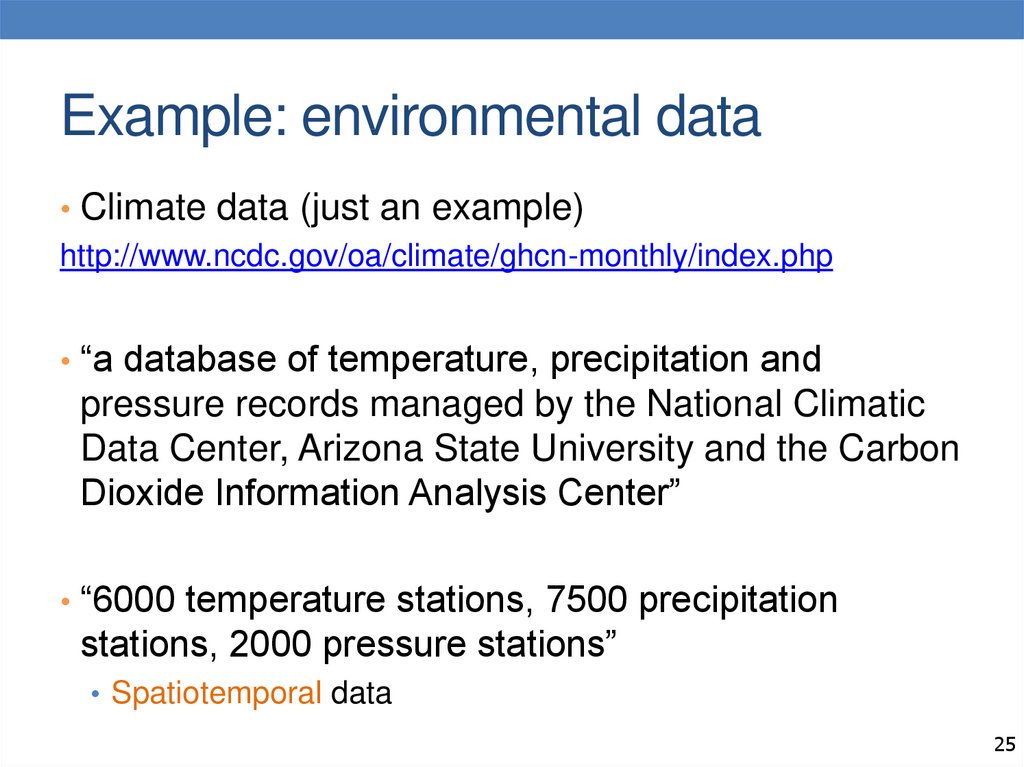











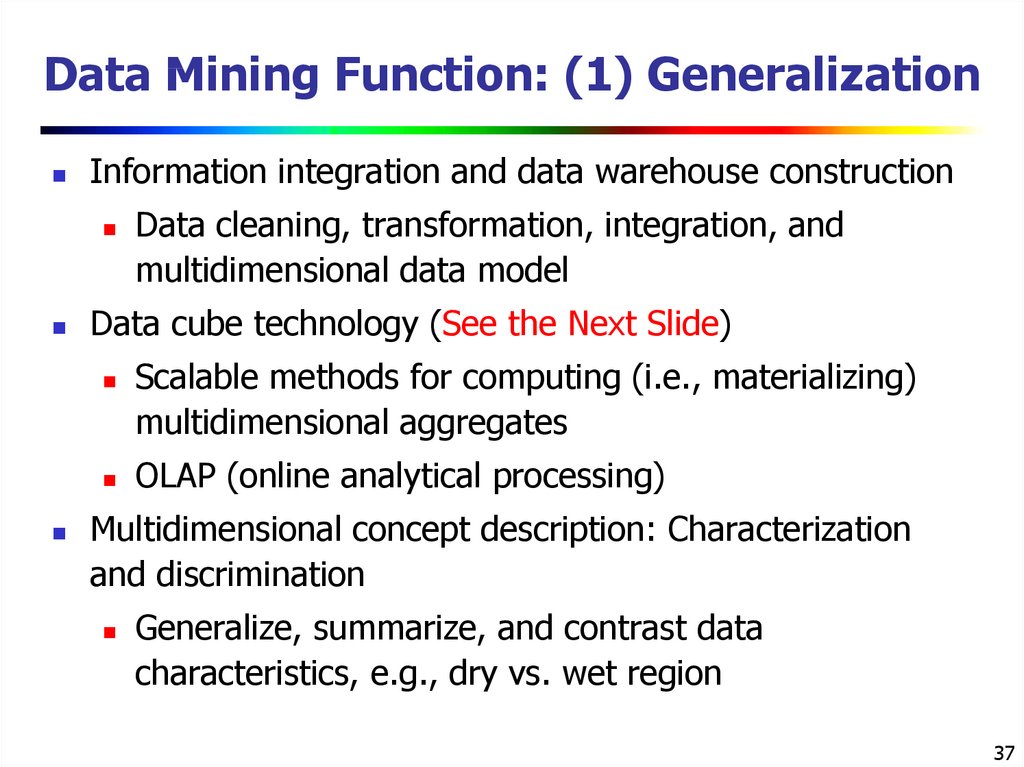




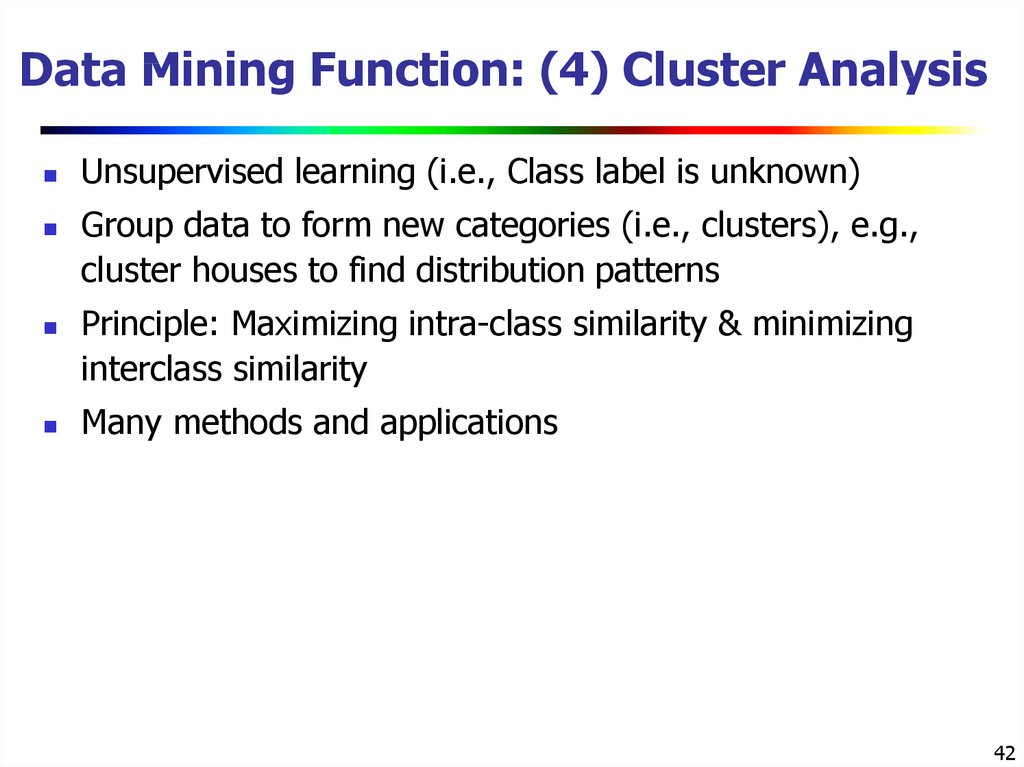







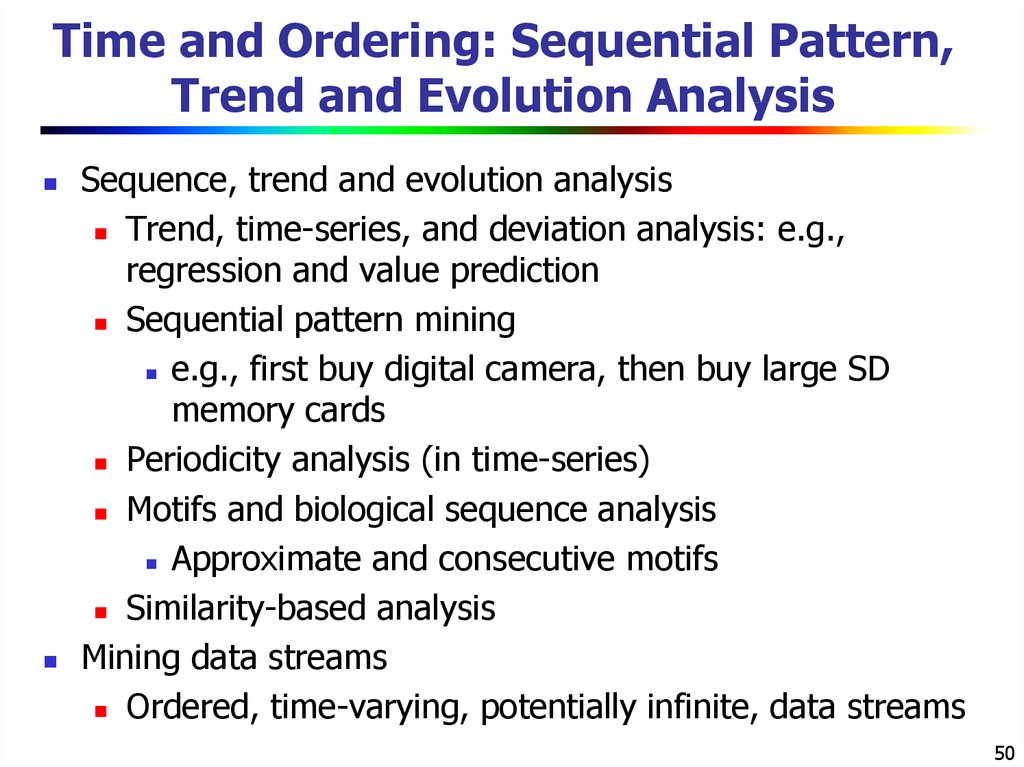
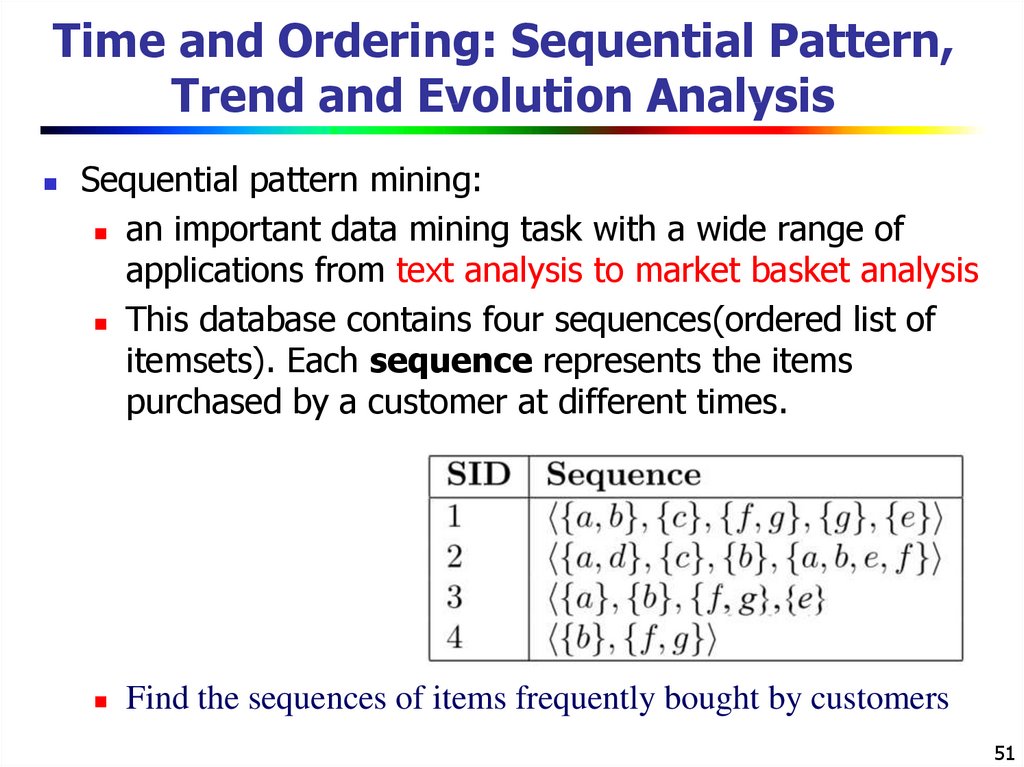

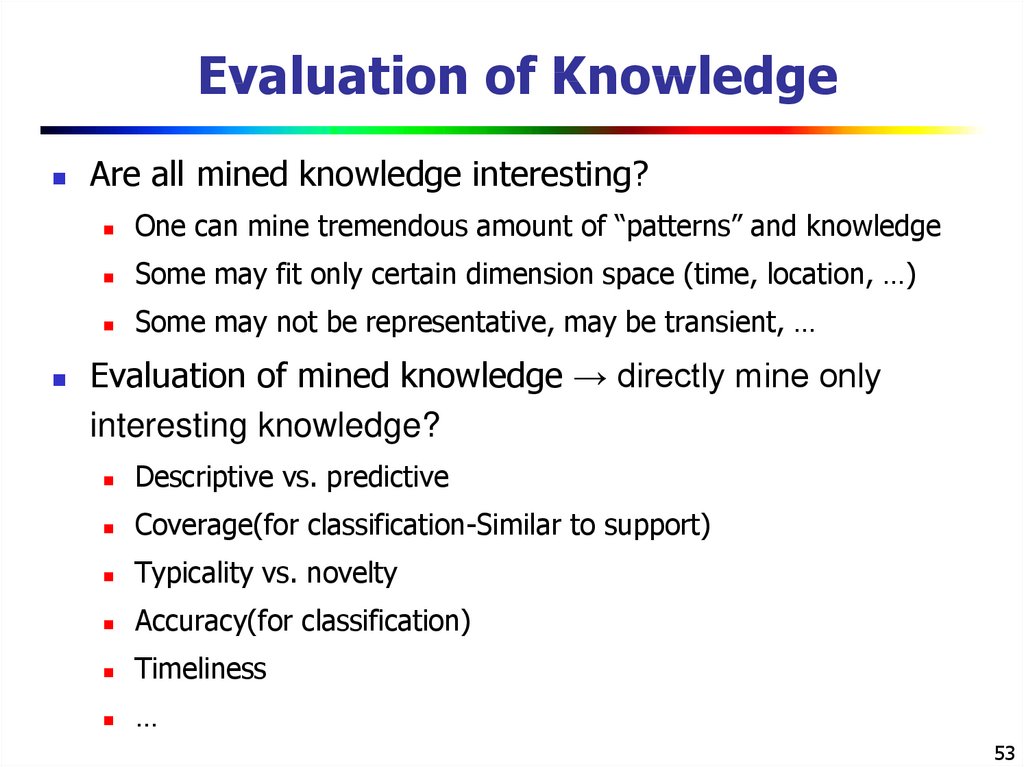









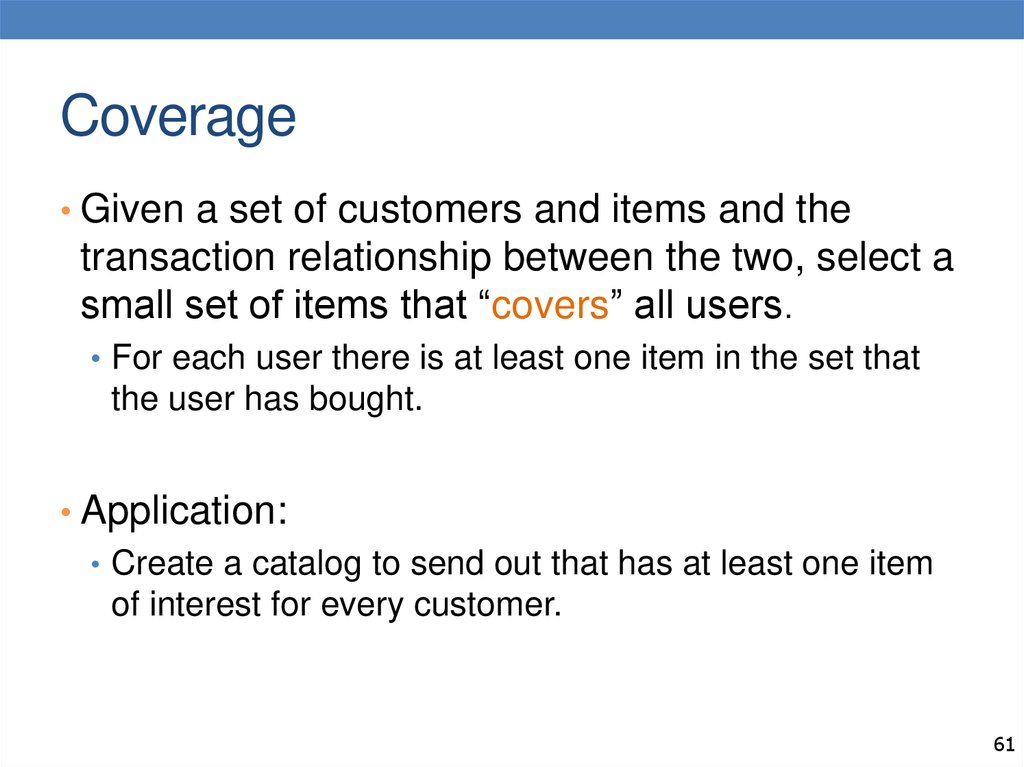

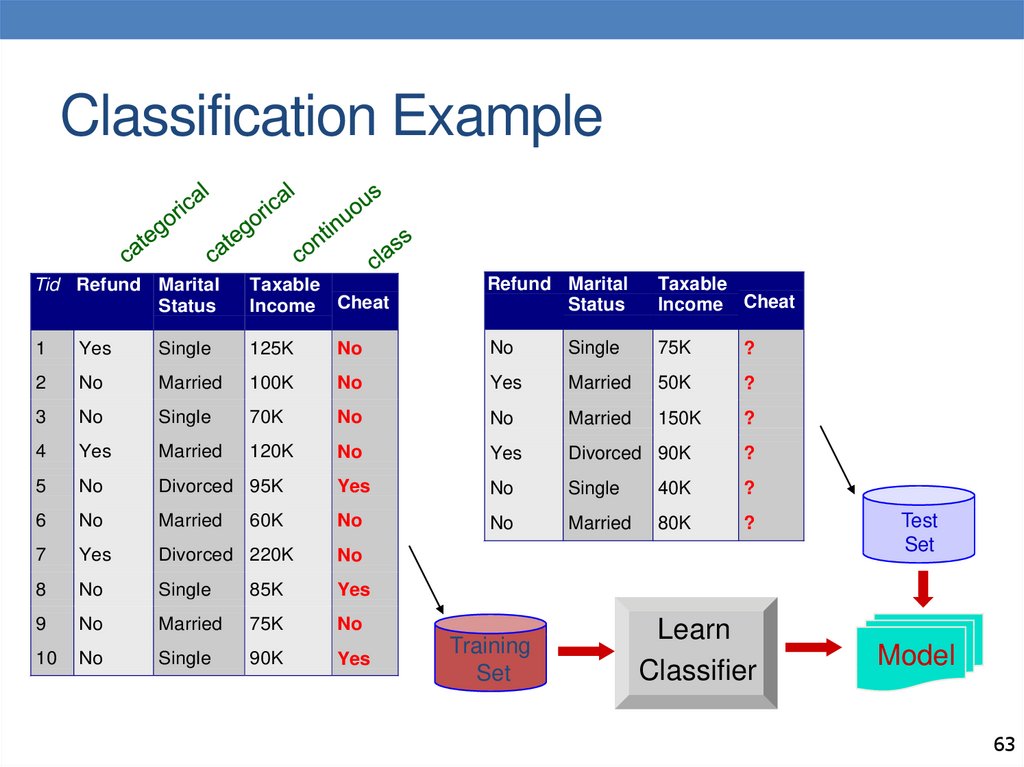


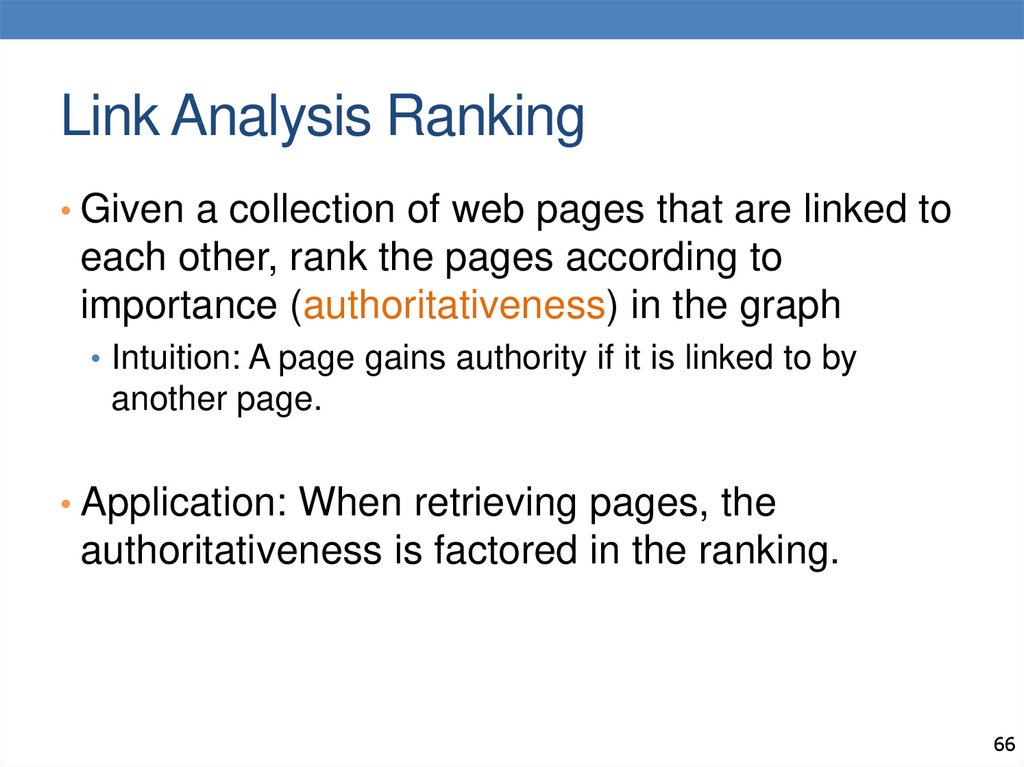
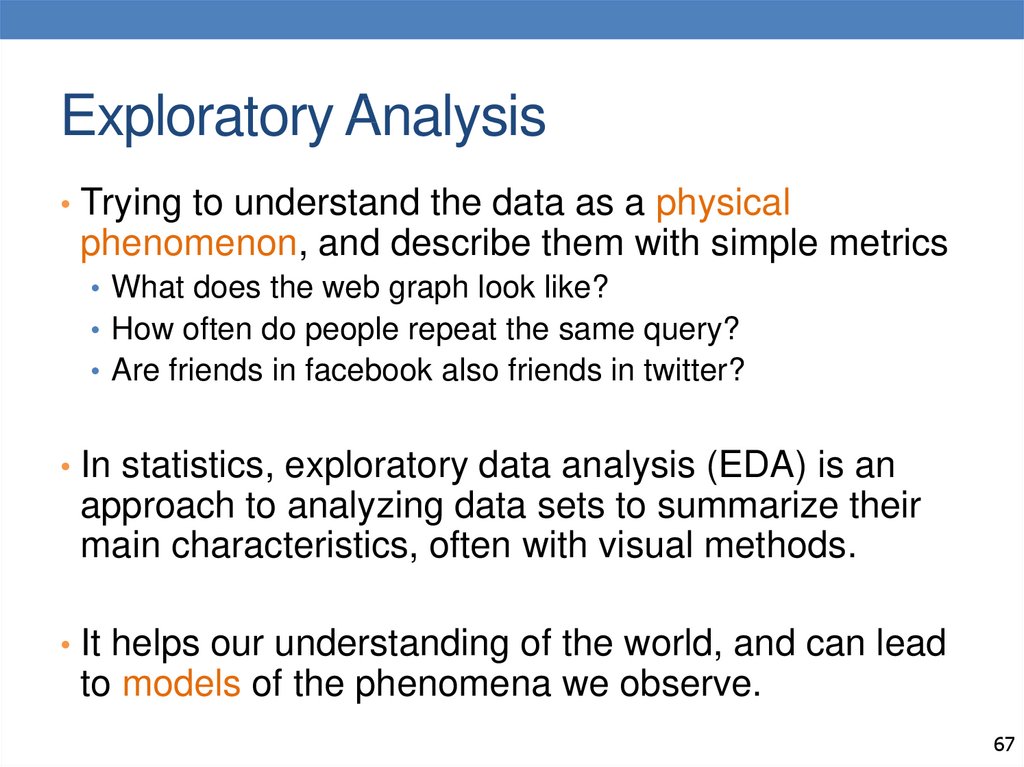


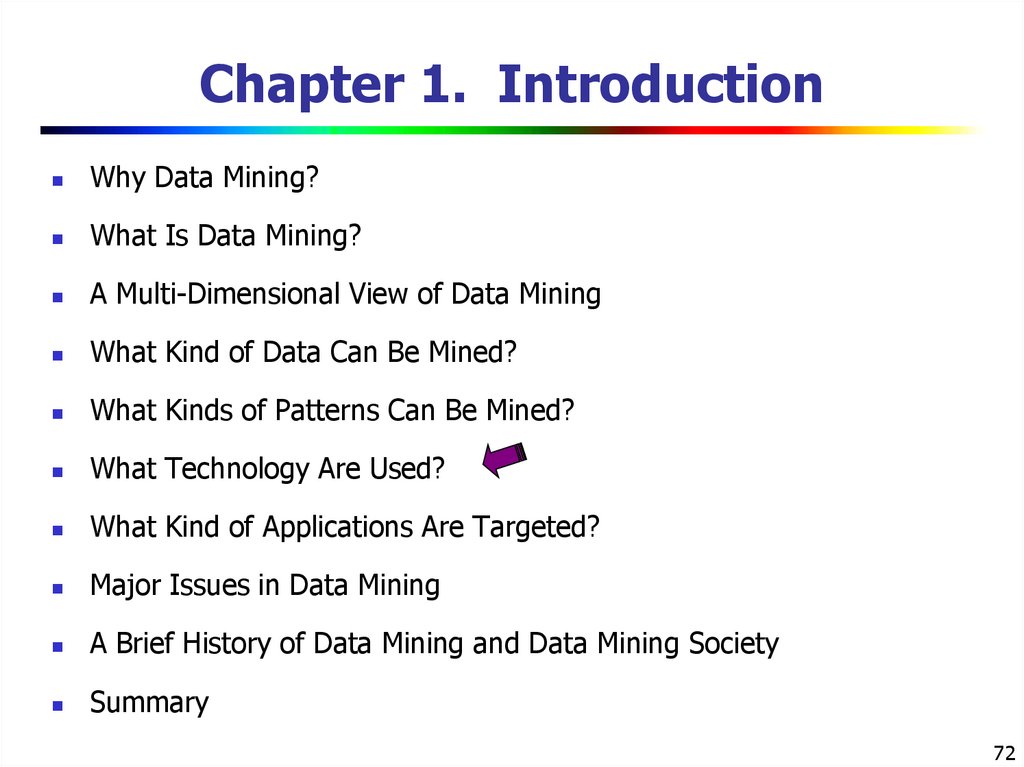





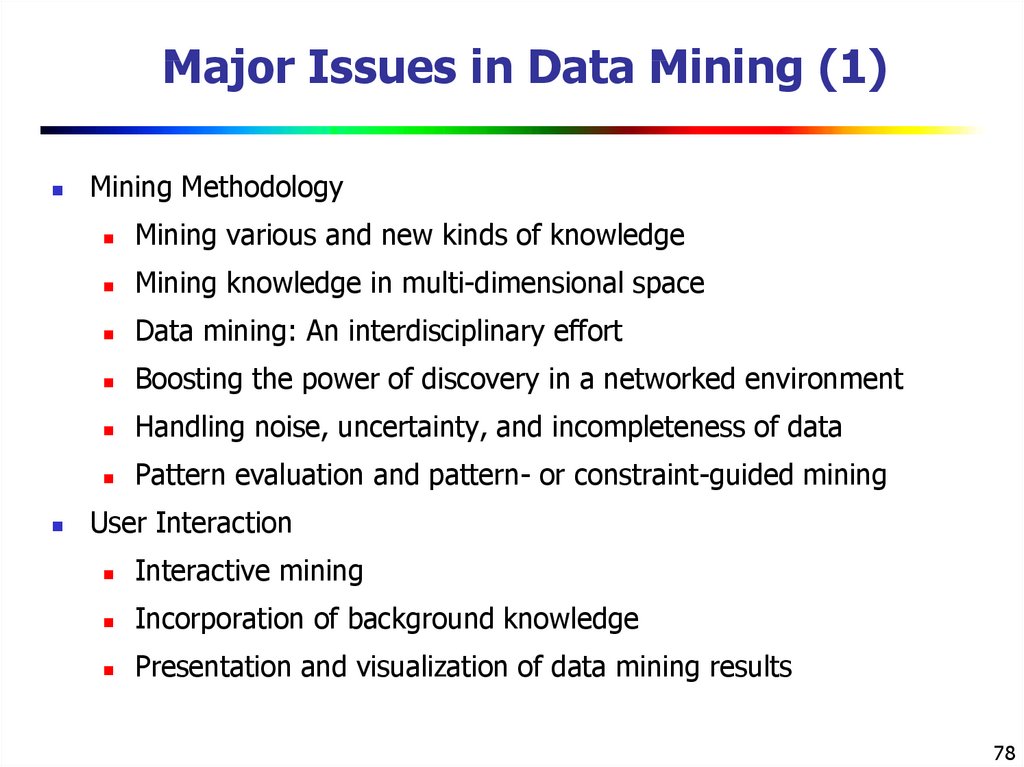



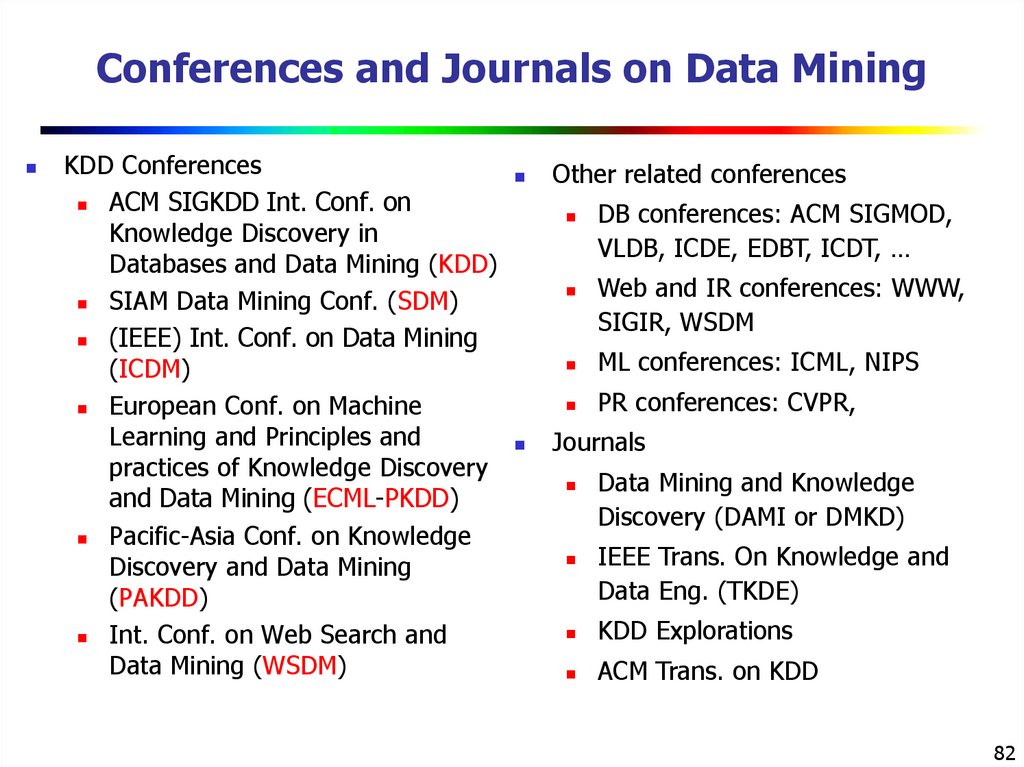






 informatics
informatics








